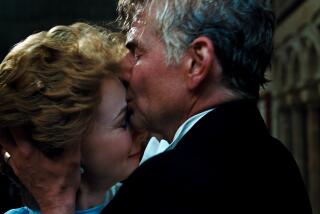MUSIC REVIEW : MASTER CHORALE PACKS ITS PASTELS
SAN DIEGO — Although the Atlanta Symphony, the St. Paul Chamber Orchestra and other American musical groups canceled their summer tours of Europe, the San Diego Master Chorale ignored the specter of terrorism and took off Monday for a 10-day singing tour of the British Isles. Saturday night at College Avenue Baptist Church, chorale music director Frank Almond and his singers performed their tour repertory for the home audience.
This highly disciplined musical ensemble should represent the city well in places such as Edinburgh and Chichester, where musical traditions extend back centuries. In the two years Almond has headed the chorale, he has fashioned an enviable, cohesive sound for this 115-voice chorus.
Responsive to his vigorous but not flamboyant direction, the chorale infused works such as Benjamin Britten’s final choral dance from “Gloriana” and Aaron Copland’s “Lark” with propulsive, rhythmic energy. The chorale filled the capacious and resonant church with fresh, vital sound.
Almond chose a program of 20th-Century British and American music, running the gamut of Ralph Vaughan Williams’ brilliant “Festival Te Deum” to Randall Thompson’s familiar choral incantation, “Alleluia,” to Michael Hennagin’s angular modern madrigal, “Walkin’ on the Green Grass.” This mix of American and British composers tended to the impressionistic side, however, with the Thompson, the three Britten choral dances and two lush songs by Frederick Delius. A little bit of pretty, pastel choral tone-painting does go a long way.
The program’s climax and sole extended work was Leonard Bernstein’s “Chichester Psalms,” a fitting symbol for this tour because an English cathedral commissioned American composer Bernstein to write it. The chorale spun out suave, arching lines to float the lyrical sections and graced its tranquil ending with delicate, well-tuned harmonies. Unfortunately, the paucity of male singers in the chorale took much of the bite out of the work’s aggressive second movement. Boy soprano Michael Chipman was adequate as soloist in the third movement, and organist Robert Plimpton mounted a secure rendition of the orchestral score, with assists from harpist Kimberly Billman and percussionist Tim McMahon.
It is hardly surprising that Almond’s chorale sports a collegiate-choir timbre, favoring a clean, flexible texture and light, pure sonority. Almond also directs San Diego State University’s concert choir and is a respected clinician on the collegiate circuit. His Master Chorale aspires to an idealized college chorus.
While few would urge Almond to turn the group into a facsimile of an old-fashioned opera chorus awash in mile-wide vibratos, surely more depth and color are to be found in a large chorus of mature voices such as the Master Chorale. A piece that would have benefited from a richer sonority was William Dawson’s arrangement of the spiritual “Every Time I Hear the Spirit,” which sounded particularly superficial.
More to Read
The biggest entertainment stories
Get our big stories about Hollywood, film, television, music, arts, culture and more right in your inbox as soon as they publish.
You may occasionally receive promotional content from the Los Angeles Times.










